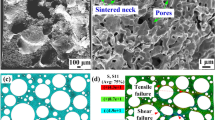Abstract
Silver has wide-ranging applications, such as industrial equipment, semiconductors, musical instruments, and silverware. Despite its diversified applications, publications on its strain-hardening characteristics are rare. In this work, tensile and hardness tests were performed for cold-rolled specimens at different levels of thickness reduction after full annealing. Up to the true strain of 1.7, strain-hardening characteristics and variations in Rockwell hardness were obtained for 99.9% pure silver. The consistency between the true stress–strain curve and the hardness data was confirmed through finite-element modeling and analysis of the hardness test procedure. Strain-hardened pure silver was verified to have yield strength comparable to sterling silver. For applications where both of purity and deformation resistance are important, strain hardened pure silver could be a practical candidate.













Similar content being viewed by others
Abbreviations
- σ :
-
True stress
- ε :
-
True strain
- \(\overline{\varepsilon }\) :
-
Equivalent strain
- s :
-
Engineering stress
- e :
-
Engineering strain
- E :
-
Young’s modulus
Reference
American Society for Metals, Metals Handbook 10th Edition: Volume 2: properties and selection: Nonferrous Alloys and Special-Purpose Materials, Coxe, C. D., McDonald, A. S., and Sistare, G. H., Jr., compilers: Properties of silver and silver alloys, pp. 699–702, ASM Handbook (1990).
Braunovic, M., Konchits, V. V., & Myshkin, N. K. (2006). Electrical contacts. CRC Press.
Flinn, R. A., & Trojan, P. K. (1999). Engineering materials and their applications. Wiley.
Hugh Ford, Ph. D., B. Sc. (Eng.), Wh. Sc., “Researches into the deformation of metals by cold rolling,” Proceedings of the institution of mechanical engineers, vol. 159, 1: pp. 115–143, Jun 1, 1948.
Ma, L., Low, S., & Song, J. (2003). Finite-element modeling and experimental comparisons of the effects of deformable ball indenters on Rockwell B hardness tests. Journal of Testing and Evaluation, 31(6), 514–523.
Ma, L., Low, S., Zhou, J., Song, J., & deWit, R. (2009). Simulation and prediction of hardness performance of Rockwell diamond indenters using finite-element analysis. Computational Materials Science and Surface Engineering, 1(1), 25–28.
Cobrzanski, L. A., Sliwa, A., & Tanski, T. (1999). Finite element method application for modelling of mechanical properties. Journal of the Mechanics and Physics of Solids, 47(7), 1589–1607.
DongWon Kim, “Plasticity,” Cheongmoon, 1996. ISBN: 89-7088-483-1.
Hill, R. (1950). The Mathematical Theory of Plasticity. Oxford University Press.
Author information
Authors and Affiliations
Corresponding author
Additional information
Publisher's Note
Springer Nature remains neutral with regard to jurisdictional claims in published maps and institutional affiliations.
Rights and permissions
About this article
Cite this article
Cho, D., Kim, JH., Kwon, H.C. et al. Strain Hardening Characteristics of 99.9% Pure Silver at Large Strains. Int. J. Precis. Eng. Manuf. 22, 1061–1067 (2021). https://doi.org/10.1007/s12541-021-00502-4
Received:
Revised:
Accepted:
Published:
Issue Date:
DOI: https://doi.org/10.1007/s12541-021-00502-4




